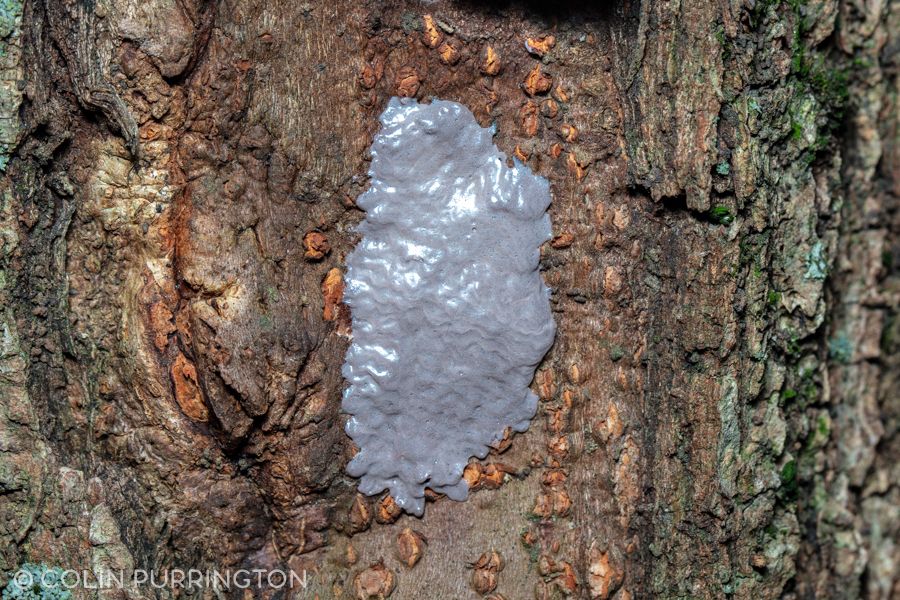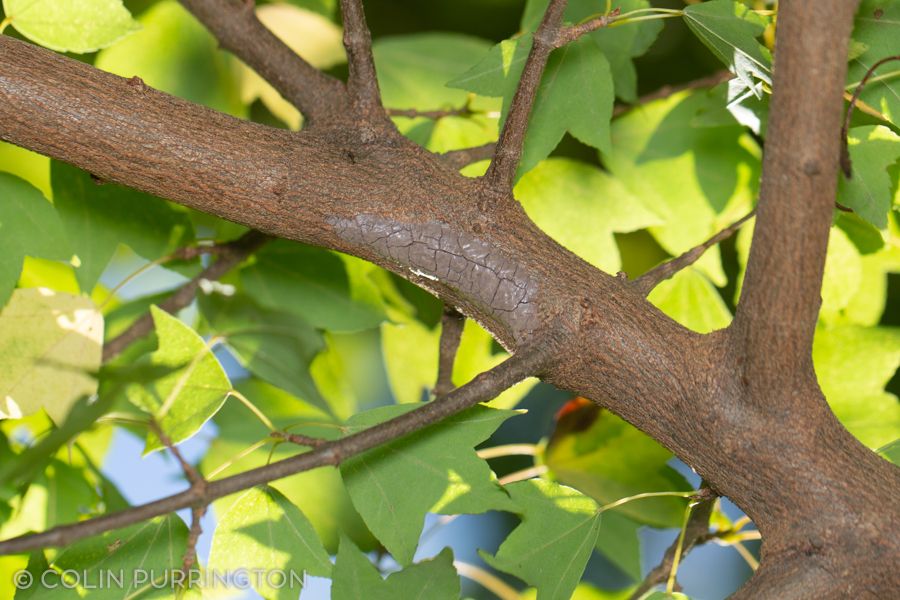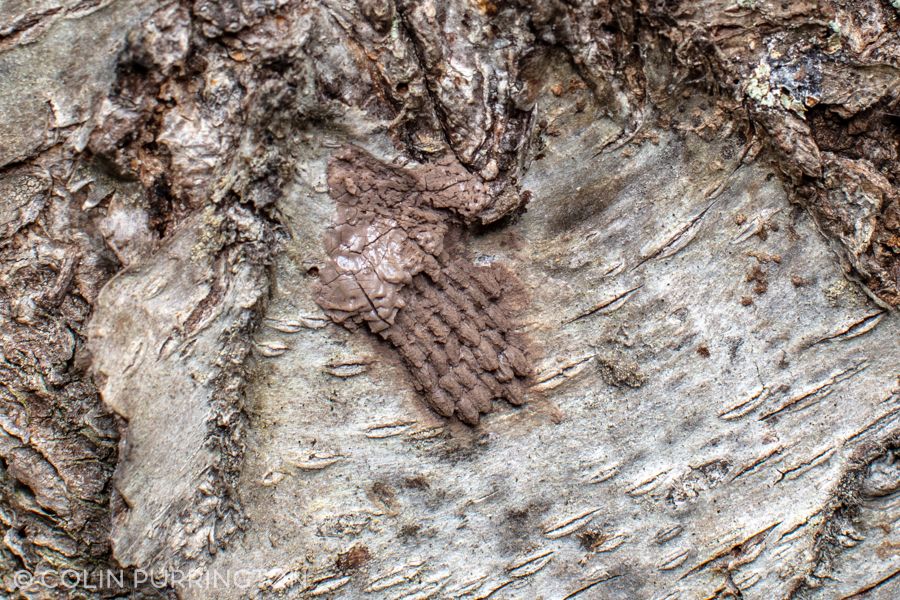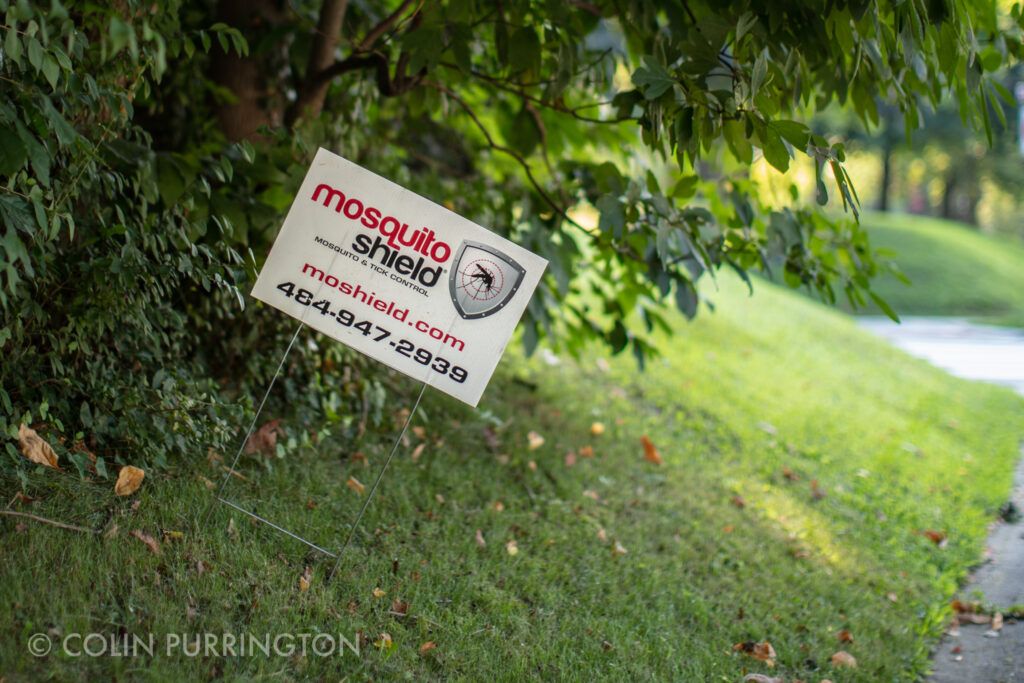Below are tips for homeowners who’d like to kill spotted lanternflies (Lycorma delicatula), invasive planthoppers from Asia that use piercing mouthparts to suck out phloem from a wide variety of trees, shrubs, and vines. It’s a futile endeavor to rid your yard of them, but you might be able to minimize damage to some of your prized plants.
First, kill your Ailanthus trees
The most important action you can take to limit population numbers in your yard is to make sure you aren’t harboring the spotted lanternfly’s favorite host plant, Ailanthus altissima (tree-of-heaven, ghetto palm), which is also from Asia and also invasive. Kill this plant with zeal and without regret, and leave no survivors. You should also locate any tree-of-heaven trees in your neighborhood and beg owners to kill them. Here are some photographs to give you a search image (click to enlarge):

Tree-of-heaven sapling 
Tree-of-heaven trunk 
Tree-of-heaven fruiting
To kill a tree-of-heaven you need to chop it down and then treat stump with herbicide (instructions). Alternatively, treat with herbicide (e.g., drill holes into trunk, squirt in herbicide such as glyphosate, tape over holes), wait until it dies (~1 month), then chop it down. If you skip the herbicide step you’ll just end up making it angry and you’ll have dozens of smaller trees in subsequent years. If you are horrified by herbicides this is the time to get over that.
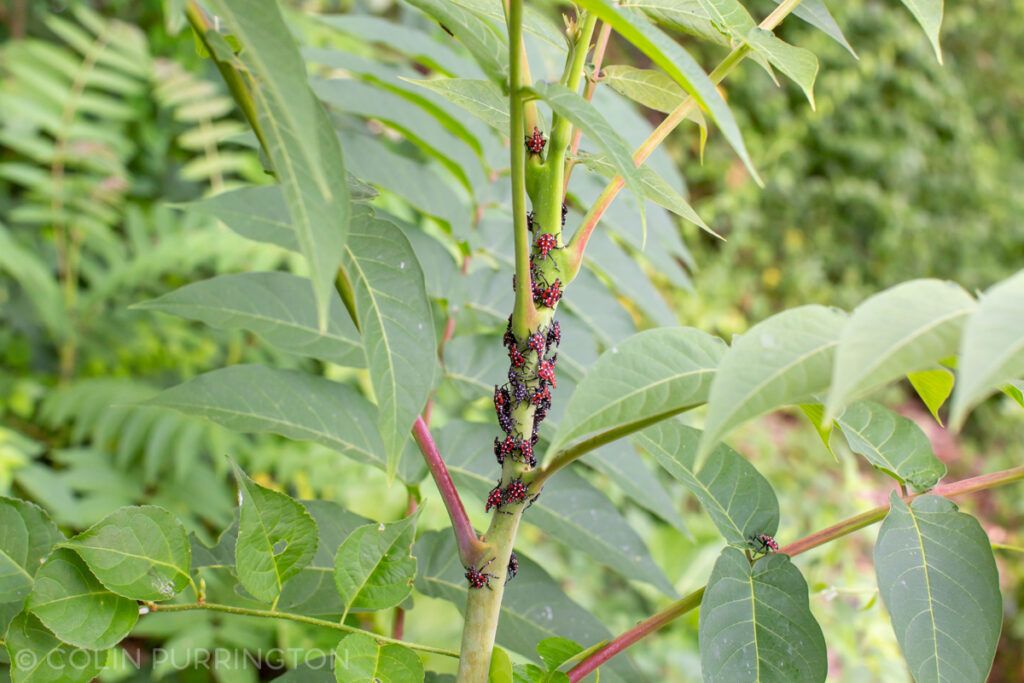
Spotted lanternfly nymphs 
Close-up of early, late nymphs
Ways to kill nymphs and adults
Flyswatter: Nothing beats a flyswatter. If you are protecting just one tree, insert a pushpin into the trunk so that you have a convenient place to hang it. Make it part of your morning routine.
Rubber bands: These work like a charm and are mildly fun. Be careful of fragile leaves, though — rubber bands can cause more damage than the insects.
Lid-container technique: Fill a container with soapy water and use the lid to motivate them to leap inside. You can kill thousands this way once you get the hang of it.
Cordless stick vacuum: A long extension arm of a stick vacuum is ideal for reaching into vegetation. I own a Dyson cordless stick vacuum but there are lots of options (e.g., on Amazon).
Backpack vacuum: If you are serious about controlling spotted lanternflies, go buy yourself a battery-powered backpack vacuum that has a large, clear repository. Then you can stroll around your yard in the evening and suck up thousands over a short period of time. A shop-vac will also work in a pinch but is much less convenient because of the cord. PRO-TIP: buy a Ghostbusters costume for your gullible child and tell them sucking up lanternflies is good practice.
Leaf vacuum: Maybe something like the Black and Decker 36v Cordless (GWC3600L). I don’t own one of these but they look fun. Amazon carries a lot. Most hardware stores can set you up. Note that most leaf vacuums shred, so be prepared for some goo.
Circle traps: These involve a little time to make but they look fantastic. Here’s a page that gives detailed instructions.
Sticky tape: I strongly advise against the use of sticky tape and spreadable goo. Sticky surfaces will certainly kill some spotted lanternflies but in my experience, not that many. The real outcome is that thousands of other, smaller insects will get trapped, which in turn attracts other, larger insects keen on eating the trapped, squirming insects. Then insectivorous birds come and get trapped (click here if you doubt me), as will bats (click here if you doubt me). Many birds and bats will likely escape but will be covered with goo and may die later. If you are unconvinced that trapped birds and bats are a problem, I urge you to Google videos of such so that you can see them suffering. Those videos are just too horrible to link to. Also, tape can leave permanent marks on your trees.
Bug-A-Salt rifle: I don’t own one of these, sadly, so I can’t absolutely guarantee it will work. But I’d be really surprised if they didn’t. I think it would make the daily lanternfly patrol really fun, and everyone in the family would want a turn. You can buy them on the Bug-A-Salt website and on Amazon. Do not buy one if you have children in the house. You can definitely shoot your eye out with these things.
Airsoft gun: Don’t get one of these if you have kids. But if you have a semi-responsible adult who enjoys killing spotted lanternflies, this would be a sweet gift. I see them as especially valuable in killing the adults that are high up in branches, out of the range of your vacuum. Buy (1) only biodegradable pellets, (2) opt for lightest pellets you can find (to minimize tree damage), and (3) wear safety goggles (the pellets ricochet off tree trucks). Note that Airsoft guns are illegal in some areas (e.g., Arkansas, parts of Michigan, Washington D.C., San Francisco, Chicago, NYC). And, of course, you always run the risk of being shot by police even if you are on your own property. To minimize the risk of being shot, DO NOT remove the blaze-orange tip.
Electric flyswatter: I own one of these and they work really well on large flies so I don’t see why they wouldn’t work on spotted lanternfly nymphs. I suspect adults wouldn’t care. There are dozens for sale on Amazon.
Pathogenic fungi: There are at least two fungi (Beauveria bassiana and Batkoa major) that seem to infect spotted lanternfly, so it might be possible to coat them with a powder or a spray and watch them slowly die. Unfortunately, the experiments on whether this is worthwhile are not yet done (or not yet published), so I can’t guarantee success. But in the wild, these fungi seem to do their thing well. I’m going to buy some Beauveria bassiana from Amazon for the 2020 season, just for giggles. Batkoa major is not yet for sale, I think. Here’s an adult I found that I think is infected.
Dawn soap: This is one of many home remedies that has gone viral but should not have. Detergents pollute waterways and can also damage plants.
Propane torch: This looks extremely satisfying (see video) but it’s just going to result in forest fires and home losses. Don’t be that guy. If you’re married to that guy, hide the propane tank.
Chinese mantids: Please do not buy mantid egg cases and release in your yard. Chinese mantids are invasive and mainly eat butterflies (even monarchs, even hummingbirds). They are not beneficial insects, despite claims to the contrary on Pinterest.
Insecticides: Unless you own a vineyard, spotted lanternflies are a nuisance insect, not a health threat. And they do not seem to be killing trees or other plants. So I do not recommend spraying them with insecticides. A typical homeowner (I include myself) is not in a position to apply pesticides safely and in an environmentally-responsible way. You’d just end up killing all the pollinators and fireflies in your yard, plus pollute local streams. It’s also, in my opinion, futile to spray: there are likely thousands of individuals in neighboring yards that will reinvade your yard in the days after you nuke it. But if you do spray, please refer to Penn State’s guidance.
I also don’t recommend that homeowners treat male tree-of-heavens (Ailanthus altissima) with systemic insecticides to create “bait” trees. It seems like a perfect solution: because tree of-heaven is their favorite host, you could potentially kill thousands of adults as they arrive to feed on insecticide-laced trees. And it’s touted as being safe for other insects because few other insects eat the foliage. The huge downside, in my opinion, is that many systemic insecticides find their way into nectar and pollen, and thus these bait trees will likely poison large number of pollinators (you’d just never know it). This downside should be especially worrying to suburban beekeepers because those chemicals could potentially end up in honey. And, more generally, the bulk of systemic insecticides is likely washed into waterways or taken up by nearby plants in your yard, not just tree-of-heaven trees.
Ways to kill eggs
There are several challenges to killing them at the egg stage. The first is that the egg masses are covered with a shiny purple/gray substance that tends to weather and blend in with tree bark over time, so finding them is difficult. Here are some photographs that illustrate the variability (click to expand).
The easiest way to kill large numbers of these insects is to find them at the egg stage and squish them. This can be done by applying enough force with a hard, flat object (stick, trowel, stiff credit card) to create a popping noise as you progress from one side of the case to the other. You should see juices being exuded.
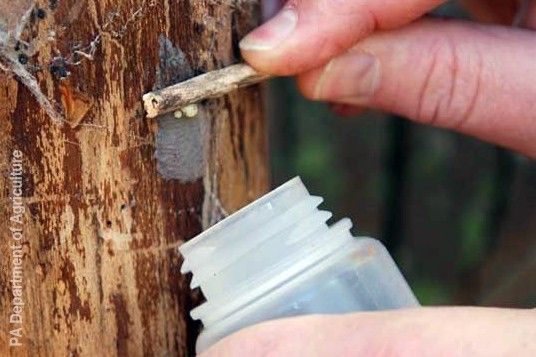
I also think that a mini rolling pin would be ideal, as would a rubber mallet.
PRO-TIP: In late winter and early spring the egg masses becomes brittle, so apply a section of wide tape over the egg case before hitting them. This prevents eggs on the edges from being launched to safety.
If you can’t stomach the sound and the goo, an alternative is to scrape the eggs into a container filled with a fluid such as alcohol or hand sanitizer, or into a container or bag that can be sealed and thrown in the trash. The important consideration here is that simply scraping them off the tree onto the ground will not kill the eggs/larvae that are inside.
Second, the egg masses are often high up in the canopy of a tree, sometimes on thin branches that you’d never be able to reach even if you are a good climber. Third, the adults have a habit of ovipositing in areas that are completely hidden from view, such as underneath a loose piece of bark, behind a seat cushion on the deck, or in a wheel well of a car. There’s just no way to find all the egg cases in a yard.
PRO-TIP: as the egg cases weather the eggs beneath the waxy substance sometimes become more visible. So make a habit of reexamining surfaces in February and March when leaves are not blocking your view. Take a cup of coffee or a glass of wine with you on patrols, to keep your spirits up. As motivation, remember that each egg case has 20-50 eggs, and they are much easier to kill than 20-50 nymphs.
As far as I know, spraying the egg cases with insecticide is not especially effective.
More information
- Delaware Department of Agriculture
- Maryland Department of Agriculture
- New Jersey Department of Agriculture
- New York Department of Agriculture
- New York State Integrated Pest Management
- Pennsylvania Department of Agriculture
- TreePhilly
- Virginia Department of Agriculture
- Northeastern IPM Center Spotted Lanternfly
© COLIN PURRINGTON


